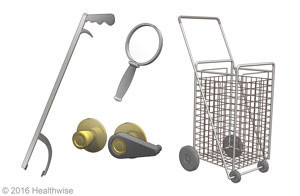Assistive Devices
What are assistive devices?
Assistive devices are tools that help you with daily activities such as bathing, grooming, dressing, walking or otherwise being mobile, writing, or eating. There are tools that can help you hold objects, open and close doors, transfer weight while shifting positions, or walk. They assist you by making certain daily activities easier to do.
These devices can be simple, such as special hooks to help you button a shirt, or elaborate, such as a power wheelchair or a computer that can be controlled by a mouth switch if you are unable to use your limbs.
Other examples include:
- Bathing tools, such as tub or shower grab bars to help you get in and out of the bathtub.
- Grooming and dressing tools, such as button or zipper hooks to help you button and unbutton your clothes, electric toothbrushes, and combs and brushes with bigger and easier-to-grab handles.
- Writing and reading tools, such as grips on pens or a magnifying glass to help with vision problems.
- Movement devices, such as canes, braces, walkers, or even electric scooters.
- Wheelchairs can also keep you mobile.
- Special lifts that can be attached to help you get in and out of your bed, automobile, or even your bathtub.
Types of Devices
Tools for daily tasks

These tools include:
- Stools, carts, trash cans, and other objects on wheels so they can be pushed rather than carried or lifted.
- Doorknob extenders. They help you open doors without twisting the doorknob.
- Molded or padded handles. They can make objects like keys, kitchen gadgets, combs, mirrors, and toothbrushes easier to hold.
- Reaching or grabbing tools. You can use them to help you pick up items from the floor or from a high shelf.
- Writing and reading tools, such as grips on pens or a magnifying glass to help you read.
Copyrighted material adapted with permission from Healthwise, Incorporated. This information does not replace the advice of a doctor.
